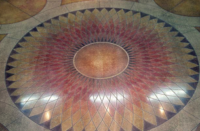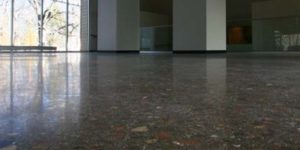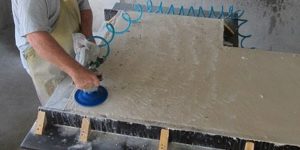Viridian Architectural Design initially wanted to resurface the ground floor of the circa 1875-1895 Fulton County Courthouse in Rochester, Indiana, with terrazzo, but the money for the pricey topping wasn’t in the budget. Still, the county was after a stone look to complement the other floors in the building. Polishing was deemed the next best thing, specifically polishing concrete to expose aggregate.
No Heavy Equipment Allowed
The contractor originally hired for the job turned out to have very heavy equipment, and county officials were unsure the century-plus-old building could withstand the weight. So, they nixed the original company and turned to Dancer Concrete Design in nearby Fort Wayne to tackle the job.

“They were worried about the weight and vibration of the machinery and how it would affect the entire structure,” says owner Nick Dancer. “The building sits on huge pillars in the basement made of Indiana limestone. There are no mechanical fasteners holding it together. It supports itself by its own weight.”
Big enough to do the 2,200-square-foot job, a 32-inch Lavina grinder was successfully used to expose the floor’s antique aggregate pattern. In the 19th century, they processed stone aggregate in concrete mixes differently. Back then the stones were large and round instead of multi-sized and angular like the stones predominantly used today.
The Process
“To get the look we were going for, we had to go with two passes. Each with a PCD (a Superabrasive poly-crystalline diamond). This was to take off about 1/4 inch,” Dancer says. “The deeper we went, the bigger the stones got.”
Contactors did all the concrete work at night. It was cleaned up each night, so county business could go on the next day. In conjunction with the polishing and, patching several areas with Metzer/McGuire’s Rapid Refloor XP. “You can’t see any of the patches,” Dancer says.
The Dancer team not only rendered a handsome floor polished to a satin 400 grit. They also solved a pinhole problem. Using an extensive grout coat of LS/CS Densifier from Prosoco. They followed with a second coat of densifier, L&M Lion Hard, and then finished the job with RetroPlate, a stain guard from Curecrete.
Refurbished and polished, the courthouse proudly maintains its listing with the National Register of Historical Places. Dancer says he’s proud to have been part of the restoration. “The reason we got the project was we were willing to be adaptable, flexible and also helpful.”
www.nickdancerconcrete.com


















